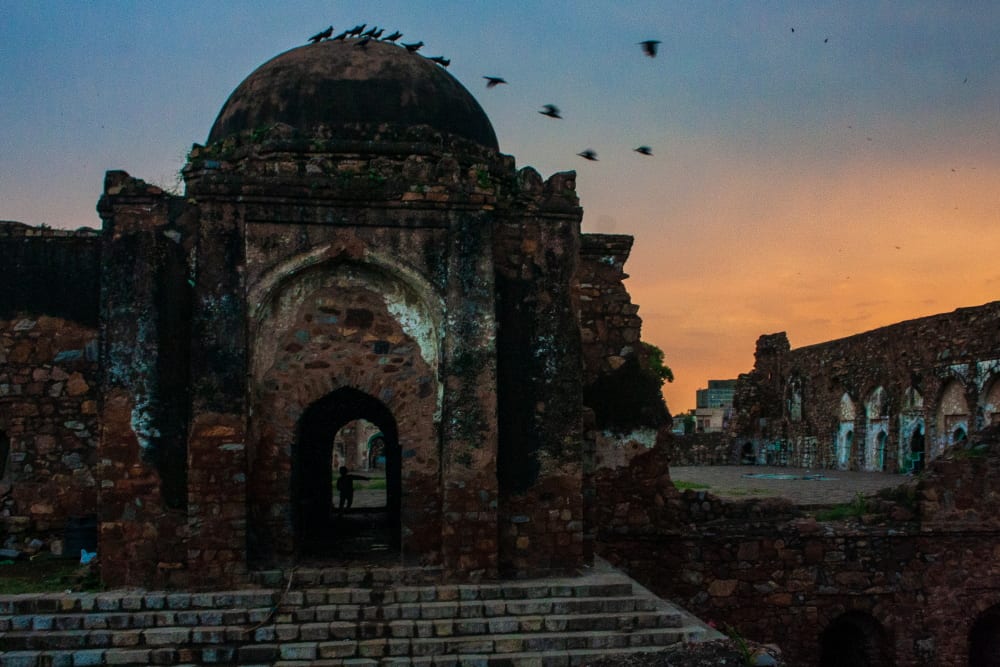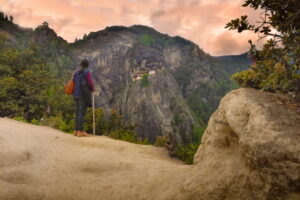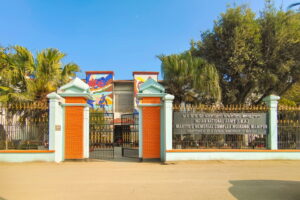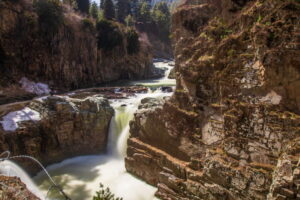Besides the newly named Arun Jaitley Stadium, formerly known as Feroz Shah Kotla Stadium, there is the ruins of the fifth city of Delhi, Ferozabad, a.k.a. Feroz Shah Kotla (Fort). The fort not only has significant historical importance, but the remnants of the mosque and the courtyard inside act as a place for large gathering during Namaz. Few of them also believe that this fort is resided by jinns who listen to their wishes and prayers and make it happen. So, Feroz Shah Kotla is an interesting place if you want to explore Delhi’s history and the cultural beliefs of the local Muslim community.

History
Feroz Shah Tughlaq, a ruler from Tughlaq Dynasty, built Feroz Shah Kotla Fort in 1354 as the new capital of the Delhi Sultanate. This Kotla or fortress was built due to scarcity of water in Tughlaqabad, the previous capital built by Ghiasuddin Tughlaq. Feroz Shah Tughlaq, who reigned in Delhi Sultanate from 1351 – 1388, built many buildings, gardens, and canals throughout the city. He also repaired Qutub Minar, Hauz Khas and Surajkund during his reign.
According to historians, Although the extent of the old Ferozabad city is difficult to trace and is believed to be extended in a semi-circular way from the Ridge on the west side to the Yamuna river in the east. It was mostly unwalled except for the citadel of the Sultan. A population of nearly 1,50,000 people inhabited the city and the major suburb was near the northern ridge where Feroz Shah’s hunting lodge was located.
The majority of the houses are destroyed when Taimur Lang defeated Nasir Ud-din Tughlaq in 1398 and ransacked the city and demolished it to the ground after killing nearly 100000 people. The Kotla later served as a building material for the construction of Shergarh and Shahjahanabad for which a major part of the boundary wall was removed.

Things to see inside
The fort is in ruins now. Once you enter through the gate on the west side which is supported by two large bastions on either side, you will walk through a passageway between the ruins. Finally, you will see a large sprawling lawn with ruins of three major structures, a three-storied pyramidal structure, said to be the residence of the Sultan, with small cells within and the Asokan Pillar at the top; the ruin of a mosque and the ruin of a stepwell or Baoli, which is in comparatively better condition than the other two.
The walls don’t have any plaster covering or any art works. As a result the masonry looks very rough and comprise of quartzite. The cells in the main palace and in the lower story of the mosque are small and have vaulted roofs which is supported by mortar.
The Asokan Pillar
Asokan Pillar is one of the most significant structures inside Feroz Shah Kotla. Sultan Feroz Shah brought this pillar which the great Mauryan Emperor Asoka erected, from its original position near Ambala in Haryana to Ferozabad or present-day Delhi.
Two such pillars, one from Ambala and another one from Meerut, were carried wrapped in cotton silk and placed inside a reed full of raw silk on a carriage made on 40 wheels and pulled by 200 men to Delhi. Upon reaching Delhi, the pillars were carried in huge boats across the Yamuna river to reach their final destinations. One was erected inside the fort in its present position, and the other near present-day Hindu Rao Hospital.
The Asokan pillar, which is inside the Feroz Shah Fort, is made of sandstone and is 13 metres in height. There are inscriptions over the pillar written in Brahmi Script, which includes the acts done by Asoka to spread the dharma (Buddhism), which James Princep later translated in the nineteenth century.

The Mosque
Jama Masjid inside Feroz Shah Kotla is one of the oldest mosques that are still in use. The mosque was built in Tughlaqui architecture. Inside, there is a prayer hall, once used by royal ladies, which is surrounded by cloisters and a large courtyard at the centre. Now, a large prayer is held every Thursday in the courtyard.
It is said that Sultan Taimur, who prayed here in 1398, was so impressed by its architecture that he built a similar mosque in Samarkhand, imitating this design.
The Stepwell
The circular stepwell or the Baoli is at the centre of a large garden on the northwestern side of the Asokan Pillar. It is a two-storied structure without any roof which had collapsed long before. The original stepwell was three-tiered and connected to the river with pipelines. The access to the Baoli is now closed and can be seen from outside only. You can seek special permission from the Archaeological Survey of India (ASI) to enter inside the stepwell.

Beliefs and myths
The present-day ruins of Feroz Shah Kotla Fort are visited by the local Muslim community not only to pray Namaz, but a part of the community also believes that jinns reside inside the ruins of the fort and they can grant a wish if it is appropriately conveyed. When I entered the complex, I was not aware of this belief and was a little curious when I saw many niches and alcoves smeared in black by the soots of the burning lamps and seepage of oil over the walls with hand-written letters adhered to it.
Islam believes that Allah created man from dry clay and jinns from smokeless fire. As a result, jinns can transform into any shape and travel any distance, making them much stronger in the human psyche. So, they are often become the support of vulnerable souls, out of fear or intimacy or sometimes both. Jinns are believed to reside in caves, jungles or deserted places like ruins. And the ruins of Feroz Shah Kotla works perfectly for such cultural practices.
It is said that the act of leaving letters and family photographs in the ruins of Feroz Shah Kotla Fort started somewhere in the 1970s around the Emergency Period when post-independence India suffered a major setback.
Locals believe that if any wish is taken by touching the Asokan pillar or the Minar-e-Zarreen as named by the Sultan Feroz Shah, it is granted by Laat (pillar) waale Baba, who is the chief of Kotla jinns.

How to reach
The Feroz Shah Kotla Fort is situated beside Bahadur Shah Zafar Marg near Maulana Azad Medical College and Lok Nayak hospital, Delhi. A road between Lok Nayak Memorial Park and Shaheed park ends at the fort’s entry gate.
You can easily access this place from anywhere in Delhi by cabs, local buses and metro trains. The nearest metro station is Pragati Maidan on the Blue Line.
The distance between Indira Gandhi International Airport and both the Old and New Delhi Railway Stations from Feroz Shah Kotla is 17 kilometres and 6 kilometres.
Google Map: Feroz Shah Kotla, Delhi
When to visit
You can visit the place throughout the year except for summer as Delhi experience a dry heatwave during that time.

Entry time:
- Dawn – Dusk
- Open on all days
Entry Fee:
- ₹20 for Indian citizens and residents of SAARC countries
- ₹250 for residents of other countries
- Buy online ticket here
Dedicated Childcare facility
ASI is going to construct a childcare room inside the citadel which will accommodate 5-6 mothers at a time.
Nearby places to see
- Raj Ghat (1 km away)
- Red Fort (2.5 km away)
- Jama Masjid (3 km away)
- Humayun’s Tomb (5.5 km away)

Book your trip: Resources
- Flight
Use Skyscanner or Google Flights to book your flight.
- Accommodation
Tripadvisor and Agoda are perfect for booking your hotel. If you want to stay in a hostel, then Hostelworld would greatly help you find one at your convenience.
- Travel Insurance
World Nomads is perfect for travel insurance. You can get comprehensive protection from them. Let them take care of unexpected situations while you concentrate on your trip.
- Package Tour and Activities
You can book a package tour from G-Adventures and Viator. They are a reputed company arranging small group tours and customising them per your requirements. You can also use Get Your Guide to book your private transport, city tours, heritage walks, food walks and other experiences like a cooking lesson or a Yoga session.
Disclosure: Some of the links below are affiliate links. You will be directed to another third-party website when you click those links. If you purchase anything via those links, I will earn a referral bonus without any extra cost to you.



